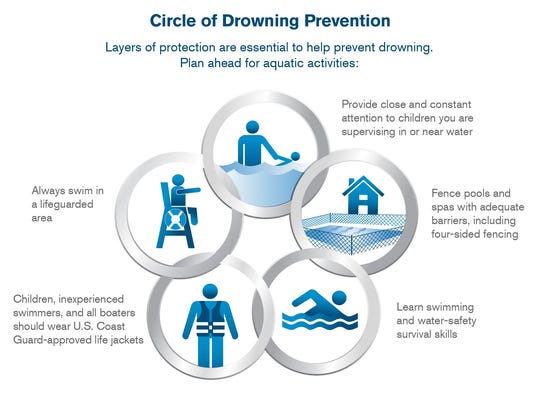A pair of drownings this summer — an 87-year-old man in Fair Lawn and a 7-year-old boy in Montclair — has underscored the necessity of safe swimming.
About one in five people who die from drowning in the United States are age 14 or younger, according to the Centers for Disease Control and Prevention. And for every child who dies from drowning, another five receive emergency care for nonfatal submersion injuries, CDC figures show.
"We really have learned over the years how close supervision is needed," said Dr. Peter Wernicki, who chairs the aquatics committee of the American Red Cross' Scientific Advisory Council, which develops data-based swim safety recommendations. "If you have a young swimmer or learning swimmer, we recommend they be in arm’s reach."
There were 10 drownings in New Jersey last year, most of which were due to ocean rip currents.
"Drownings happen quickly, quietly, silently and in the best of families," said Judith Josephs, who is the education chairwoman for the aquatics section of the New Jersey Parks and Recreation Association.
Starting young
Brian McLaughlin, the head coach for the men's and women's swimming teams at Montclair State University and the school's assistant director of athletics, encourages parents to start with swim lessons as early as 2 years old.
As families become busy with specialized sports, McLaughlin said, they sometimes don't realize that learning basic swimming skills is more important than learning the average sport, because it is a safety issue.
"There are so many swim programs that are available to families in this area," McLaughlin said. "It's important for parents to carve out the time, at least for the developmental years of their children, to take swim lessons because once a person becomes comfortable in the water, that usually will not go away."
11 Photos
Photos: Teaching swim safety at Paterson B&G Club
This week in Paterson, aquatic skills were taught as part of a four-day program sponsored by the Connecticut-based nonprofit ZAC Foundation, a national group that brings water safety lessons to children ages 5 to 9 in urban environments, such as Paterson and Passaic.
“Studies show that children who do not have access to water are so much more likely to drown,” said Wendy McGuire, the deputy executive director for the Boys & Girls Club of Paterson and Passaic, which is hosting the foundation's lessons in North Jersey. "But once they have that skill they will pass that on to future generations.”

Tips from the American Red Cross on preventing drowning. (Photo: Courtesy of the American Red Cross)
This year, Josephs said, her foremost concern is preventing drownings in residential and hotel pools, where there is no state requirement for a lifeguard to be present.
"The New Jersey bathing code is tough on public pools, but it has no bearing on backyard pools," Josephs said. "It has to meet the building code, but once they're inspected nobody goes back to check them."
And Wernicki, of the Red Cross, said that when it comes to flotation devices, it is best to stick with Coast Guard approved life vests.
"Inner tubes, floaty things and rafts are probably more dangerous than not having them because kids use them and get into the deep water, or out into the ocean, and now they’re over their heads," he said.
Swim safety tips
The American Red Cross offers the following swimming safety tips:
- Adults should actively supervise children and stay within arm’s reach of young children and newer swimmers.
- Ensure everyone in the family learns to swim well, knows their limitations and recognizes and avoids water hazards.
- Learn how to help prevent and respond to emergencies around water.
- Enclose your pool in with 4-sided fencing that is at least 4 feet high and use self-closing, self-latching gates.
- Swim as a pair near a lifeguard’s chair. Everyone, including experienced swimmers, should swim with a buddy in areas protected by lifeguards.
- If in a location with no lifeguards, such as a residential pool, designate a person to keep a close eye on children in and around the water.
Get off the phone
In Millburn, Bob Hogan, director of the township’s Recreation Department, which runs a municipal pool at Gero Park, has seen more parents gabbing on the phone instead of attending to their children.
"I know there is WiFi and a lot of computer use," Hogan said. "But when you have to watch your kids, you have to adjust how much you use the phone."
Parents with multiple children, he said, should prioritize staying with their children who are the least skilled swimmers.
Lifeguards aren't enough
In Verona, where a lifeguard saved a 12-year-old from nearly drowning in the town’s pool last year, Jim Cunningham, director of Community Services, also is asking parents to help the lifeguards.
“Whether it’s at a pool, ocean lake, wherever you are, there is a [misunderstanding] that when the lifeguards are there, you don’t need to keep your eyes out,” said Cunningham, who noted up to 1,000 people visit Verona's town pool on a busy day.
In the majority of near-drownings, including last year’s in Verona, spectators spotted victims and alerted a lifeguard, Cunningham said, citing figures provided by the municipality’s insurance provider.
New Jersey Health Department figures released in May for the years 2006 through 2016 show 630 drowning deaths statewide. They are the most recent statewide figures available from the Health Department, a spokeswoman said.
When on beaches
- Wear a Coast Guard-approved life jacket when on a boat and if you're in a situation beyond your skill level.
- If you plan to swim in the ocean, a lake or river, be aware that swimming in these environments is different than swimming in a pool and ensure you have the skills for these environments.
- Swim only at a beach with a lifeguard, within the designated swimming area. Obey all instructions and orders from lifeguards and ask them about local conditions.
- Swim sober and with a buddy. Know your limitations and make sure you have enough energy to swim back to shore.
- Don’t dive headfirst. Walk carefully into open waters. Watch out for and avoid aquatic life.
- If you are caught in a rip current, try not to panic and don't fight the current. Signal to those on shore that you need assistance.
- Swim parallel to the shore until you are out of the rip current. Once you are free, swim toward shore. If you can't swim to the shore, float or tread water until you are free of the rip current and then head toward shore.
What about 'dry drownings'?
There is one issue parents do not have to worry about: so-called "dry drownings," Wernicki said.
"If your child has some respiratory problems in the water, if they actually just come back to normal and they’re fine and they’re happy and they’re not coughing, wheezing, short of breath or loopy, then they’re going to be fine," Wernicki said.
If the child is having respiratory issues, common sense should prevail, he said.
"If they’re not getting better, you take them to the emergency room and they’ll be fine," Wernicki said. "Everybody needs to calm down."
Email: kadosh@northjersey.com



